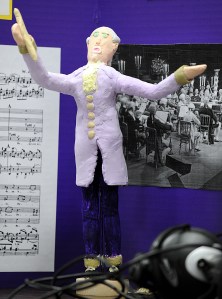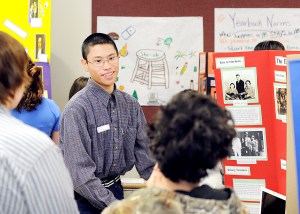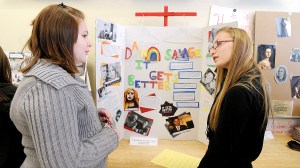POLAND — Did you know that the theme song for the movie “Titanic” was playing in one of the Costa Concordia’s restaurants when the Italian cruise ship struck a rock and foundered off the Isola del Giglio in January?
Moira MacEachen does.
Moira is a seventh-grader at Bruce M. Whittier Middle School and on Tuesday, Whittier History Day, she and all her fellow 7th and 8th middle school classmates were showing off their research projects. The theme was Revolution, Reaction and Reform.
“The ‘Titanic’ probably wouldn’t have sunk, if she’d hit the iceberg head-on,” Moira said.
The “Titanic” was the first ship to be declared “unsinkable,” Moira’s partner, Kylie Nielson, explained. “And did you know that Molly Brown, the ‘unsinkable’ Molly Brown, had been on maybe two or three other ships that went down before she went on the ‘Titanic’?”
The day was a culmination of six weeks worth of research from library books, online searches and programs such as “Comic Life” to dress up a display unlike anything available a generation ago.
Students quizzed other students and about 20 volunteer judges with clipboards asked questions and scribbled away as a smattering of parents watched.
“Nowadays, there are laws about about how many lifeboats you have to have and how everyone has to have a life jacket, and you get your money back,” MacEachen said.
On the other side of the room, eighth-grader Ethan Letourneau bounced to the beat of the Beastie Boys.
“In 1986 they first went to the top with “Fight for Your Right to Party.” They were the beginning of white rap. Did you know rap is just poetry set to music?” he asked.
And, Letourneau pointed out, the early Beastie Boys wore medallions with the Volkswagen emblem to set themselves off from established rappers who wore BMW medallions to show off their wealth.
“They wore them to show they weren’t that rich, but that they were going to have fun with what they had,” Letourneau said.
Allison Emery, a seventh-grader, researched Ida B. Wells-Barnett, who helped found the N.A.A.C.P. and the Negro Fellowship League.
“She risked her life to help others,” Emery said.
Emery told how Wells-Barnett had been born a slave in 1862, and in the post-Civil War Jim Crow era she became a fearless anti-lynching crusader.
“It really started in 1884 when she got kicked off the Chesapeake & Ohio Railroad for not giving her seat to a white woman,” Emery said. Wells-Barnett decided that she was going to let people know what was going on, she said.
According to information unearthed by Emery, 1,294 white people and 3,442 black people were lynched in the United States between 1882 and 1962, but the numbers dropped as years went on, thanks to Wells-Barnett’s work to publicize lynchings.
“She fought for what she believed in. She could have been killed,” Emery said. “I’m not sure I have the courage to do what she did. I would need my friends to help me do it.”
After about an hour and a half of interviewing and hearing stories, the judges retired to a conference room to compare notes and compile scores.
The students will be given feedback and final grades based on historical accuracy, use of evidence to support ideas, and overall quality of their projects.
Students with the top projects will go to Augusta for Maine History Day on March 28 and compete for a chance to go to Washington for National History Day in late April.





Comments are no longer available on this story